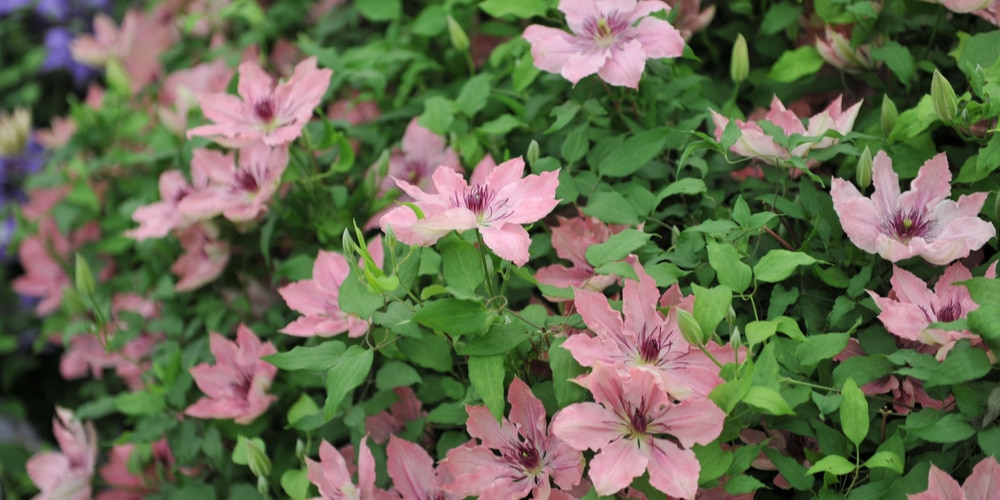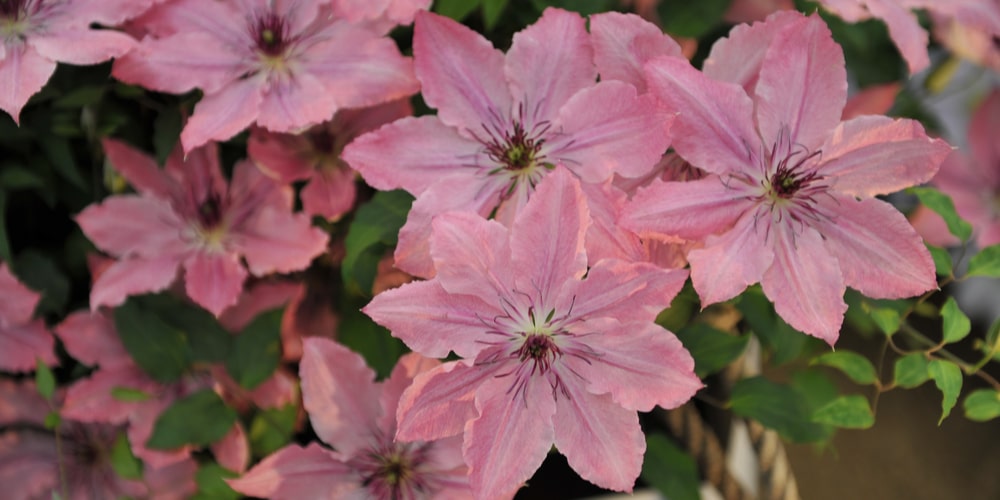Sarah Elizabeth Clematis, one of the most famous plants in gardens, can grace us with its masses of beautiful pink flowers during late spring and late fall. Its vibrant pink flower seems to glow from afar and looks stunning when planted in rows or used as a border plant.
If you’re looking for a plant that will make your garden pop, here are some important things you need to know about Sarah Elizabeth Clematis care.
| Botanical Name | Clematis Sarah Elizabeth |
| Common Name | Sarah Elizabeth |
| Plant Type | Perennial |
| Flower Color | Vibrant pink flowers with a tinge of purple |
| Size When Mature | 48-60 inches tall, 12-36 inches wide |
| Bloom Time | Late Spring to Late Fall |
| Sun Requirements | Full sun to Shade |
| USDA Hardiness Zones | 4 – 9 |
| Soil PH Range | 6.5 – 7.0 |
| Soil Type | Slightly acidic, organic-rich, well-draining soil |
| Water Needs | Medium |
| Native Area | Japan and China |
What You Need to Know About Sarah Elizabeth Clematis
Sarah Elizabeth Clematis is a popular garden plant that features large, pink flowers. This plant grows vigorously and can reach up to 4 feet in height. Although this is more compact than other Clematis varieties, their showy and vibrant blooms more than makeup for it.
This plant is a deciduous climber; this plant also grows as a bushy specimen that can be mixed well with other shrubs in the garden. Additionally, it has a big personality, as big as its flowers, with petals that can reach up to 6 inches in diameter. It has ruffled, serrated edges and a deep pink color that fades to white near the center.
It matures within 2-3 years and might not bloom during its first year. This is partly due to its complex root system, which needs time to develop fully. Assisting and training it to climb on a support structure is also one of the most essential parts of Sarah Elizabeth Clematis’ care.
How to Care for Sarah Elizabeth Clematis
Here’s everything you need to know about growing and caring for a thriving Saral Elizabeth Clematis:
Light
This beautiful shrub loves sunlight and needs at least 6 hours of it every day. While this Clematis variety may tolerate a bit of shade, the morning sun plays a big role in the production of vibrant pink blossoms.
Although they’re rarely planted as houseplants, if you’re growing them indoors, place them in a sunny spot near a south-facing window. You’d want to rotate the pot every few days to ensure it doesn’t dry out and that all areas receive enough sunlight.
Water and Soil Needs
Although they love the sun, Sarah Elizabeth Clematis likes its roots to stay cool, especially during the hot summer months. This means that the soil should be well-drained, rich in organic matter, and kept moist at all times.
Mulching is often the solution to keeping the roots cool and moist. Add a 2 to 4-inch layer of organic mulch to significantly help with moisture retention. Make sure the mulch doesn’t touch the stem, as this may cause the plant to rot.
This plant doesn’t need too much water once established. As long as it’s in free-draining soil, you only need to water it when the topsoil starts to feel dry.
You may also want to test your soil’s pH levels. It should be within the 6.5 – 7.0 soil pH range. This is crucial as the right pH levels help prevent nutrient deficiencies that could lead to a lackluster display of flowers.
Temperature Requirements
It’s been said that Sarah Elizabeth Clematis blooms better after being in a dormant period for about 6 weeks. Hardy in USDA zones 4-9, this vine can tolerate night temperatures as low as 45 degrees Fahrenheit. The plants will stay dormant once the temperature dips below the said temperature.
Fertilizer
The best fertilizer to use on a Sarah Elizabeth Clematis is a potassium-rich fertilizer. Apply evenly around the plant’s base – and feed it once a month during the growing season. You may also want to add some organic matter to the soil to help it retain moisture and nutrients.
Water immediately after fertilizing to help the plant absorb the nutrients it needs. Additionally, adding mulch after fertilizer application also helps to keep the roots cool and moist. It can be garden compost, well-rotted manure, or shredded bark.
Common Diseases
Unfortunately, Sarah Elizabeth Clematis may suffer from different diseases that may significantly affect its growth and flowering display. Clematis slime flux is one of the most common diseases. This is often a result of poorly pruned stems that have been cut too close to the ground. Once the infection sets in, a sticky substance will ooze out from the wound site.
To prevent this, make sure to clean your pruning tools before and after use. You should also avoid wounding the plant while pruning.
Clematis green petal is another disease that’s often caused by too much nitrogen in the soil. This results in the flowers having green or yellow petals instead of the usual pink hue.
Sarah Elizabeth Clematis Propagation
This deciduous vine can be propagated in numerous ways, but taking cuttings is the most common method. Look for double-leaf bud cuttings in late summer or early fall. These are the best times to take cuttings as the plant is actively growing.
Let the cuttings take root, which usually takes about 2 months. After that, you may transplant them into their own pots or into the ground.
Related Article: Clematis Companion Plants


